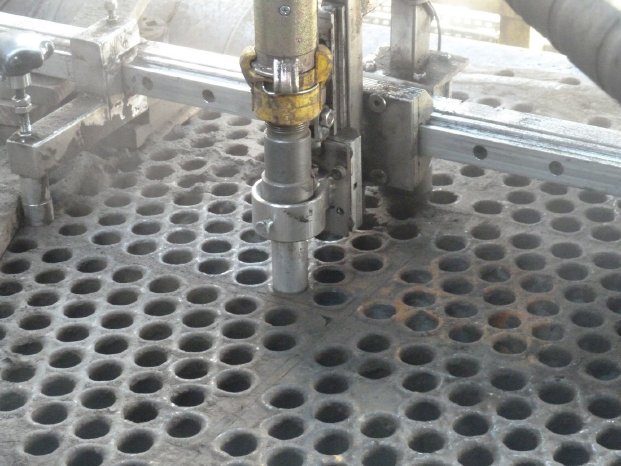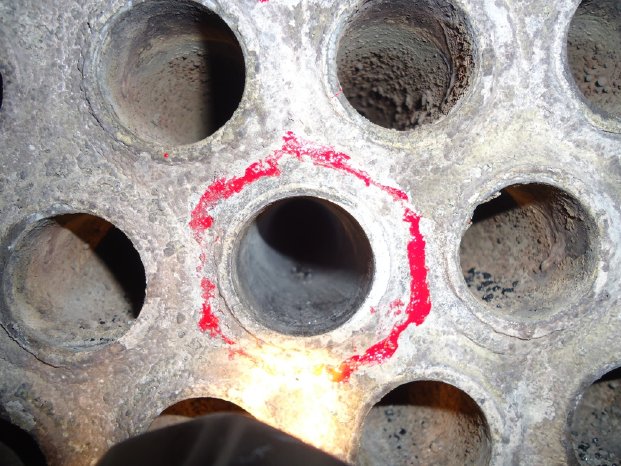Sulfurcrete, in the hardness comparable with granite, is consisting of elemental sulfur, salts formed from sulfur, CO2, SO2, NH3, and Claus catalyst dust. It is a familiar problem for Claus plant operators, as it tends to accumulate and obstruct tubes in sulfur condensers, resulting in the formation of sulfuric acid traces and subsequent corrosion. The removal of sulfurcrete is a notoriously difficult and time-consuming task, requiring extensive downtime for SRUs.
Traditional methods, such as drilling, often cause damage to the equipment and are less effective due to the material‘s hardness. Additionally, sulfurcrete is insoluble in most common solvents, rendering washing ineffective. Despite the prevalence of this issue in the approximately 1,000 Claus plants worldwide, no satisfactory solution had been found – until the introduction of the TubeMaster system.
1. The Challenges of Sulfurcrete in Sulfur Recovery
1.1 The Importance of Sulfur Recovery Units
Sulfur recovery units play a critical role in processing sour gas, which contains high levels of hydrogen sulfide (H2S). H2S is a toxic and corrosive gas that poses significant environmental and safety concerns. SRUs convert H2S into elemental sulfur, which can be safely stored, transported, and utilized in various industrial applications. The Claus process, the most widely employed method for sulfur recovery, relies on thermal and catalytic reactions to convert H2S
into sulfur. The efficiency of SRUs is vital to meeting environmental regulations, reducing greenhouse gas emissions, and minimizing health risks.
1.2 The Formation and Impact of Sulfurcrete
Sulfurcrete forms under specific conditions within Claus plants, particularly in areas with lower temperatures, such as sulfur condensers. The condensation of sulfur and the presence of salts from CO2, SO2, and NH3, along with dust from Claus catalysts, result in the formation of this hard, granite-like material. Sulfurcrete deposits cause several problems in SRUs, including:
- Obstruction of tubes in sulfur condensers, leading to reduced heat transfer efficiency and decreased sulfur recovery.
- Formation of sulfuric acid traces beneath the sulfurcrete layer, causing corrosion and equipment damage.
- Increased maintenance and downtime requirements for removing sulfurcrete deposits, negatively impacting SRU on-stream time and overall plant performance.
1.3 The Limitations of Traditional Sulfurcrete Removal Methods
Traditional methods for removing sulfurcrete from SRUs, such as drilling and washing, have proven to be less than optimal. Drilling is a time-consuming process that can cause damage to the tube’s surfaces, leading to increased wear, reduced lifespan, and the increased potential for future deposit formation. Washing with common solvents is generally ineffective, as sulfurcrete is insoluble in most solvents, particularly those that are easy to handle.
Figure 2: Schematic diagram of a Claus Plant. F1: Claus furnace with waste-heat boiler; C1: Sulfur separator; W1, W2: Preheaters; R1, R2: Catalytic reactors; W3, W4: Sulfur condensers; F2: Incinerator
2. Blasting for Removal of Sulfurcrete: The TubeMaster Solution
2.1 Process Description
The mycon TubeMaster system utilizes abrasive blasting agents to clean SRUs, with the specific blasting agent selected based on the desired surface condition. mycon's specially designed nozzles are precisely adjusted to meet the requirements of each application. The TubeMaster system excels at removing even the hardest deposits, leading to significant improvements in surface quality and with that the efficiency of heat exchangers. By enhancing the surface condition, TubeMaster also makes future cleanings easier, as deposits are less likely to adhere to the improved surfaces. mycon has a wealth of experience in cleaning and surface improvement for various types of pipes, including steel, stainless steel, bronze, red bronze, copper, brass, titanium, aluminum, plastic, and graphite. For curved pipes, specific criteria must be considered during the blasting process.
Figure 3: TubeMaster principle. View inside a tube, blasting material is accelerated and cleaning the wall because of the nozzle.
2.2 TubeMaster AS: The Semi-Automated Solution
The TubeMaster AS, a semi-automated version of the system, is designed to achieve high cleaning quality through precisely controlled cleaning speeds. This not only reduces the consumption of blasting media but also minimizes the physical strain on the operators. The TubeMaster AS can be used for cleaning both vertically and horizontally oriented shell-and-tube heat exchangers.
Figure 4: TubeMaster AS
2.3 Sulfurcrete Removal with TubeMaster
In Claus plants, sulfur condensers are typically operated at temperatures between 125°C and 160°C. At higher temperatures, sulfur becomes highly viscous, impeding its free flow from the condenser. Conversely, at temperatures below 125°C, the temperature difference to the sulfur solidification point (approximately 119°C) becomes too small, reducing the efficiency of the condenser. Operating at higher temperatures may simplify the process, but it comes at the cost of reduced sulfur recovery, as some sulfur vapor passes through the condenser unrecovered. This trade-off is often unacceptable due to stringent regulations regarding sulfur recovery, however multiple stages can be used. Although operators have tried various methods to mitigate the problem of plugging in sulfur condensers, none have provided a complete solution. Eventually, tubes in the sulfur condensers accumulate sulfurcrete deposits, leading to reduction in the heat transfer and blockages. TubeMaster overcomes this challenge by offering a more effective and less damaging alternative to traditional drilling methods.
3. Comparison to Other Cleaning Methods
Although TubeMaster may be more expensive than other cleaning methods, such as high-pressure water, it offers numerous advantages that often outweigh its higher price. These advantages include:
- Removal of even the hardest deposits, where other methods fail
- Gentle on the surface and to the tube, no measurable reduction in wall thickness
- Dry cleaning process
- Excellent cleaning results
- Improved surface quality within pipes
- Significant energy savings
- Extended operating times
- Environmentally friendly cleaning with the recovery of used materials
TubeMaster is particularly well-suited for sour gas processing, where it is essential to keep equipment dry during and after cleaning and where it is beneficial to reduce the downtime. TubeMaster has been successfully employed in various applications, also in SRU units, as in the Gulf States and at one of the world's largest low-density polyethylene (LDPE) producers, where a sulfur condenser required a perfect cleaning for an IRIS inspection. In this case, dry cleaning was necessary due to the presence of sulfur, and mechanical alternatives failed to produce satisfactory results, even after intensive trials. TubeMaster successfully achieved the desired outcome.
4. Summary
TubeMaster offers a a versatile and effective solution for cleaning tubes with diameters as small as 3 mm, removing deposits ranging from soft materials like oils and fats to hard substances such as sulfurcrete. The cleaning process does not result in any reduction of wall thickness, leaving the original wall thickness intact. Furthermore, TubeMaster enables in-place cleaning of equipment, eliminating the need for disassembly and re-assembly. The cleaned surfaces often exhibit better smoothness after treatment, reducing adhesion and extending the intervals between cleanings.
With a wealth of experience available at Mycon, TubeMaster's additives and blasting process can be optimized for specific applications. This innovative system can help increase online time and ensure better economy for sulfur recovery operations.
Mycon provides consultation and support during the initial implementation of the TubeMaster system at a customer's site, ensuring a seamless integration and smooth operation. The company also offers ongoing training and support to operators, enabling them to maximize the benefits of the TubeMaster system in their facilities.
5. Environmental and Economic Benefits
The TubeMaster system delivers several environmental and economic benefits for sulfur recovery plants, including:
- Reduced sulfur emissions: By improving the efficiency of sulfur condensers, TubeMaster enables Claus plants to comply with stringent environmental regulations and minimize sulfur emissions.
- Energy savings: The improved heat transfer efficiency in cleaned sulfur condensers results in reduced energy consumption, lowering operating costs and contributing to a greener operation.
- Waste minimization: TubeMaster's abrasive blasting agents can often be recovered, reducing waste generation, and lowering the environmental impact of the cleaning process.
Sulfur recovery is a crucial aspect of sour gas processing and a primary concern for the petrochemical and refining industries. The buildup of sulfurcrete deposits in sulfur condensers has long posed significant challenges for these operations. Traditional cleaning methods, such as drilling and washing, have proven inadequate and often damaging to the equipment.
The TubeMaster system, developed by mycon, offers a game-changing solution to this persistent problem. By employing abrasive blasting technology, TubeMaster efficiently and effectively removes sulfurcrete deposits without causing damage to the equipment surfaces. The result is improved heat transfer efficiency, reduced corrosion, and extended operating times for sulfur recovery units. Furthermore, the system is environmentally friendly, with the potential for abrasive agent recovery and reuse.
The TubeMaster system represents a significant leap forward in the optimization of sulfur recovery operations. Its combination of effectiveness, time savings, and environmental benefits make it an ideal solution for addressing the challenges posed by sulfurcrete deposits in the petrochemical and refining industries.







